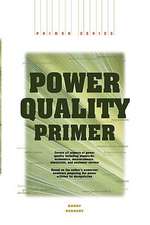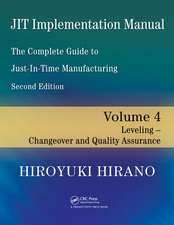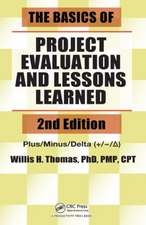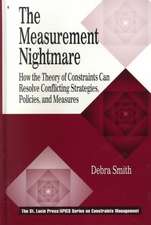Design for Manufacturability: How to Use Concurrent Engineering to Rapidly Develop Low-Cost, High-Quality Products for Lean Production, Second Edition
Autor David M. Andersonen Limba Engleză Hardback – 27 mai 2020
Design for Manufacturability: How to Use Concurrent Engineering to Rapidly Develop Low-Cost, High-Quality Products for Lean Production is still the definitive work on DFM. This second edition extends the proven methodology to the most advanced product development process with the addition of the following new, unique, and original topics, which have never been addressed previously. These topics show you how to:
- Cut cost from 1/2 to 1/10 in 9 categories—with ways to remove that much cost from product charges and pricing
- Commercialize innovation—starting with Manufacturable Research and learning from the new section on scalability, you will learn how to design products and processing equipment to quickly scale up to any needed demand or desired growth. Design product families that can be built "on-demand" in platform cells that also "mass customize" products to-order
- Make Lean production easier to implement with much more effective results while making build-to-order practical with spontaneous supply chains and eliminating forecasted inventory by including an updated chapter on "Designing Products for Lean Production"
- Engineers who want to learn the most advanced DFM techniques
- Managers who want to lead the most advanced product development
- Project team leaders who want to immediately apply all the principles taught in this book in their own micro-climate
- Improvement leaders and champions who want to implement the above and ensure that the company can design products and versatile processing equipment for low-volume/high-mix product varieties
| Toate formatele și edițiile | Preț | Express |
|---|---|---|
| Hardback (2) | 479.55 lei 43-57 zile | |
| Taylor & Francis – 27 mai 2020 | 479.55 lei 43-57 zile | |
| Taylor & Francis – 4 feb 2014 | 501.92 lei 43-57 zile |
Preț: 479.55 lei
Preț vechi: 564.17 lei
-15% Nou
Puncte Express: 719
Preț estimativ în valută:
91.76€ • 96.06$ • 75.93£
91.76€ • 96.06$ • 75.93£
Carte tipărită la comandă
Livrare economică 07-21 aprilie
Preluare comenzi: 021 569.72.76
Specificații
ISBN-13: 9780367249946
ISBN-10: 0367249944
Pagini: 590
Ilustrații: 55 Illustrations, black and white
Dimensiuni: 156 x 234 x 32 mm
Greutate: 0.97 kg
Ediția:2nd edition
Editura: Taylor & Francis
Colecția Productivity Press
Locul publicării:Oxford, United Kingdom
ISBN-10: 0367249944
Pagini: 590
Ilustrații: 55 Illustrations, black and white
Dimensiuni: 156 x 234 x 32 mm
Greutate: 0.97 kg
Ediția:2nd edition
Editura: Taylor & Francis
Colecția Productivity Press
Locul publicării:Oxford, United Kingdom
Public țintă
Professional Practice & DevelopmentCuprins
List of Figures. Preface. About the Author. SECTION I Design Methodology. Chapter 1: Design for Manufacturability. Chapter 2: Concurrent Engineering. Chapter 3: Designing the Product. SECTION II Flexibility. Chapter 4: Designing for Lean and Build-to-Order. Chapter 5: Standardization. SECTION III Cost Reduction. Chapter 6: Minimizing Total Cost by Design. Chapter 7: Total Cost. SECTION IV Design Guidelines. Chapter 8: DFM Guidelines For Product Design. Chapter 9: DFM Guidelines for Part Design. SECTION V Customer Satisfaction. Chapter 10: Design for Quality. SECTION VI Implementation. Chapter 11: Implementing DFM. SECTION VII Appendices. Appendix A: Product Line Rationalization. Appendix B: Summary of Guidelines. Appendix C: Feedback Forms. Appendix D: Resources. Index.
Notă biografică
David M. Anderson, Dr. of Engineering, is the world’s leading expert on using concurrent engineering to design products for manufacturability. Over the past 27 years presenting customized in-house DFM seminars, he has honed these methodologies into an effective way to accelerate the real time-to-stable production and significantly reduce total cost.
His book-length website, www.HalfCostProducts.com, presents a comprehensive cost reduction strategy (summarized in Section 6.3) consisting of eight strategies, all of which can offer significant returns as stand-alone programs and even greater results when combined into a synergistic business mode. DFM is a key strategy because it supports most of the others. Dr. Anderson shows clients how to apply these strategies for cost reductions ranging from half cost to an order-of-magnitude (summarized in Section 3.8) which he teaches in customized webinars and workshops all over the world while providing consulting breakthrough concepts for products and platforms (see last page of Appendix D).
In the Management of Technology Program in the Haas Graduate School of Business at University of California at Berkeley, he wrote and twice taught their Product Development course. He wrote the opening chapter in the DFM Handbook (Vol. 6, of the Tool & Manufacturing Engineers Handbook) published by SME
His second book on mass customization, Build-to-Order & Mass Customization: The Ultimate Supply Chain Management and Lean Manufacturing Strategy for Low-Cost On-Demand Production Without Forecasts or Inventory, is described in Appendix D.2.
Dr. Anderson has more than 35 years of industrial experience in design and manufacturing. For seven years, his company, Anderson Automation, Inc., built special production equipment and tooling for IBM and OCLI and did design studies for FMC, Clorox Manufacturing, and SRI International. As the ultimate concurrent engineering experience, he personally built the equipment he designed in his own machine shop. He has been issued four patents and is working on more.
Dr. Anderson is a fellow of ASME (American Society of Mechanical Engineers) and a life member in SME (Society of Manufacturing Engineers). He is a certified management consultant (CMC) through the Institute of Management Consultants. His credentials include professional registrations in mechanical, industrial, and manufacturing engineering and a doctorate in mechanical engineering from the University of California, Berkeley, with a major in design for production and minors in industrial engineering, metalworking, and business administration.
Dr. Anderson can be reached via email: anderson@build-to-orderconsulting.com. His websites are www.design4manufacturability.com and www.HalfCostProducts.com.
His book-length website, www.HalfCostProducts.com, presents a comprehensive cost reduction strategy (summarized in Section 6.3) consisting of eight strategies, all of which can offer significant returns as stand-alone programs and even greater results when combined into a synergistic business mode. DFM is a key strategy because it supports most of the others. Dr. Anderson shows clients how to apply these strategies for cost reductions ranging from half cost to an order-of-magnitude (summarized in Section 3.8) which he teaches in customized webinars and workshops all over the world while providing consulting breakthrough concepts for products and platforms (see last page of Appendix D).
In the Management of Technology Program in the Haas Graduate School of Business at University of California at Berkeley, he wrote and twice taught their Product Development course. He wrote the opening chapter in the DFM Handbook (Vol. 6, of the Tool & Manufacturing Engineers Handbook) published by SME
His second book on mass customization, Build-to-Order & Mass Customization: The Ultimate Supply Chain Management and Lean Manufacturing Strategy for Low-Cost On-Demand Production Without Forecasts or Inventory, is described in Appendix D.2.
Dr. Anderson has more than 35 years of industrial experience in design and manufacturing. For seven years, his company, Anderson Automation, Inc., built special production equipment and tooling for IBM and OCLI and did design studies for FMC, Clorox Manufacturing, and SRI International. As the ultimate concurrent engineering experience, he personally built the equipment he designed in his own machine shop. He has been issued four patents and is working on more.
Dr. Anderson is a fellow of ASME (American Society of Mechanical Engineers) and a life member in SME (Society of Manufacturing Engineers). He is a certified management consultant (CMC) through the Institute of Management Consultants. His credentials include professional registrations in mechanical, industrial, and manufacturing engineering and a doctorate in mechanical engineering from the University of California, Berkeley, with a major in design for production and minors in industrial engineering, metalworking, and business administration.
Dr. Anderson can be reached via email: anderson@build-to-orderconsulting.com. His websites are www.design4manufacturability.com and www.HalfCostProducts.com.
Descriere
Explains how to use concurrent engineering to design products for the lowest cost, highest quality, and quickest time to stable production. It shows how to simultaneously make major improvements in all these product development goals, while enabling effective implementation of Lean Production and Quality programs.


















